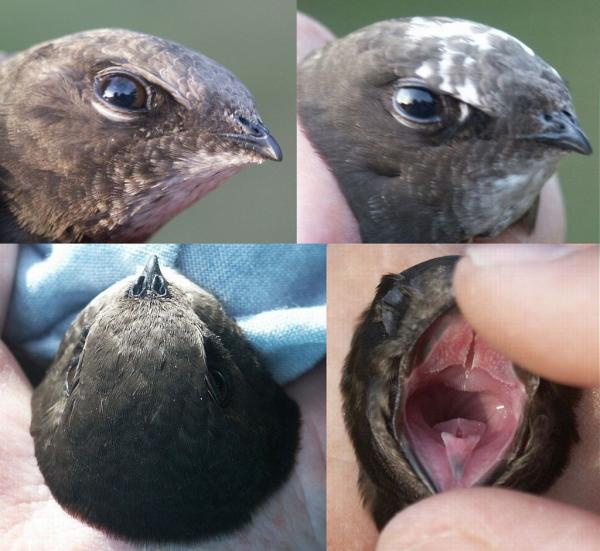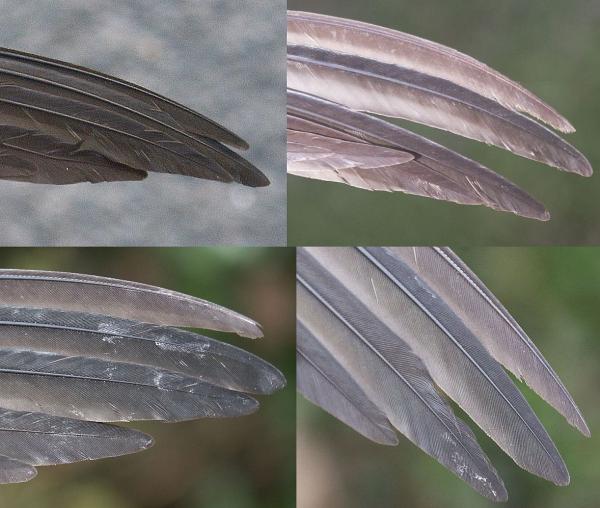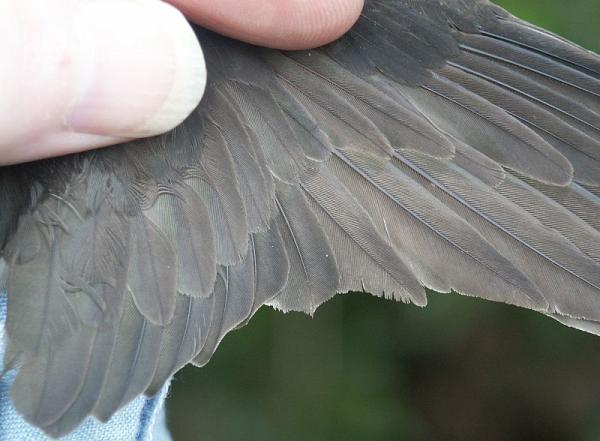Adult Swifts at a colony (21 July 2003)
I have an unusual site where Swifts Apus apus can be mist-netted as they emerge from their nest-holes. Most Swift nesting sites are high up, of course, and the special feature of this site is that the eaves are only about 4 metres above ground. Adult Swifts are reportedly quite sensitive at breeding sites, so I have only netted the site once a year and always left it until late July when the chicks should be well-grown. The main point of the work is to see the year-to-year returns of birds to their breeding colony. Most Swifts are caught opportunistically at feeding sites, and their breeding colonies are not known.
This year's catch total was 10 birds, 5 new and 5 retraps from previous years. All were adult females. The history of the five retraps was: one ringed in 1996 and also caught in 2000; one ringed in 1999 and not seen since; one ringed in 2000, also being retrapped for the first time; and two ringed in 2002.
Structurally, Swifts are unusual. The wings are long and pointed, with the 9th (counting from the inside) primary the longest and the outermost p10 a few millimetres shorter. Their tails are short and quite deeply forked. They don't like posing for photographs but this shows a bird with a lot of white feathers on the top of its head.
.jpg)
The wing feathers often have a glossy green iridescence that doesn't show up well on photos, and there is a lot of variation in the colour and apparent wear of different feathers:

I think that much of the variation can be explained by their very extended moult period. They take about six months to moult in Africa, so maximising their flying efficiency, but it means that the age of the feathers differs a lot. Their first (innermost) primaries are grown in September and thus about 10 months old, while the last-grown feathers (the inner secondaries) might be grown in March or April and so are only about 3 months old. The newest feathers have not seen much of the African sun, either, but Swift feathers seem to bleach much more slowly than those of many other migrant species. The two largest feathers of the alula usually seem pale brown and worn: I wonder if this is because they spread the alula a lot during their in-flight manoeuvres. While most feathers are brownish, the median coverts (especially the median primary coverts) nearly always seem black.
Ringers always notice the short tarsi, needing special overlap rings, and the pamprodactyl feet, with all four toes pointing forwards - ideal for clinging to walls, but not much use for anything else - and needle-sharp claws. The head is broad but their bill is small, with comparatively large nostrils, and the gape is enormous, going almost from one side of the head to the other. Another feature of Swifts that ringers notice is their propensity to carry hippoboscid flat-flies, but we found none on these birds, and I only had one bird infested out of eight caught in 2002.

Three of the 10 birds had an 'old' (previous generation) outermost 10th primary. These three are shown, along with a 'normal' wing, with all feathers of the same generation, at the top left:

The old p10s are paler brown (more bleached), more worn and more pointed at the tip. As it happens, all three with an 'old p10' were retraps, first ringed at the colony in 1999, 2000 and 2002. They were all of unknown age when first ringed, but reference books such as Birds of the Western Palaearctic state "age of first breeding probably 4 years". In fact, out of 65 handlings of birds at this colony over the years, 14 have had an old p10.
One of these birds with an old p10 also had an old 1st secondary feather, and what appears to be an old 1st primary as well :

This photo also shows how much variation there is in the shape and the wear of the primary coverts. The innermost one usually seems small, rounded and often glossy-greenish; the next two on this bird are quite worn and shaped a bit like the primary tips themselves; while the rest of the primary coverts are broad and rounded with little abrasion.
There seems to be a view amongst some ringers that an old p10 is characteristic of a second-year, Euring age 5, bird. My understanding of Baker's non-passerine guide (Baker, Kevin. Identification Guide to European Non-Passerines. BTO Field Guide No. 24, 1993) is that 5s have very narrow and abraded primaries, and that the occasional 7 (third calendar year) might be identified by a p10 unmoulted since hatching (thus two years old) and little more than a ragged shaft. But those with a p10 looking like these in this photo are clearly of any age: the 1996 retrap may well be 11 years of age or more. The BTO Moult Guide (Ginn, H. B. and D. S. Melville. Moult in birds. BTO Field Guide No. 19, 1983) suggests that an individual bird might leave its p10 unmoulted every fifth year on average. This figure also corresponds with my 14/65 handlings (roughly equalling 1 in 5) with a retained p10. Unfortunately, I've had no bird with an old p10 in two different years.
David Norman.